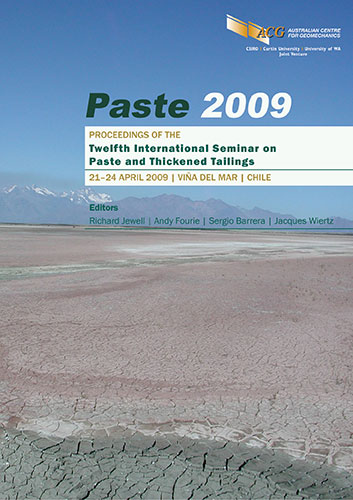Integrated Waste Management Strategy

|
Authors: Longo, S; Clarke-Whistler, K; Palkovits, F |
DOI https://doi.org/10.36487/ACG_repo/963_17
Cite As:
Longo, S, Clarke-Whistler, K & Palkovits, F 2009, 'Integrated Waste Management Strategy', in R Jewell, AB Fourie, S Barrera & J Wiertz (eds), Paste 2009: Proceedings of the Twelfth International Seminar on Paste and Thickened Tailings, Australian Centre for Geomechanics, Perth, pp. 141-150, https://doi.org/10.36487/ACG_repo/963_17
Abstract:
The mining operations conducted in Northern Ontario are generally considered to be among the richest deposits in the world. This extensive area includes multiple active mines, smelters, and refineries. A number of active waste dumps for tailings, slag, and waste rock also exist. It has been recognised that if current market conditions continue, and if the new reserve estimations are accurate, mining in this area could potentially continue for an additional 50 years. Operational difficulties for the organisations operating in this area arise from the fact that the mining operations are situated in some cases within the city limits and, in fact, also dominate a number of small communities around the mine sites. These organisations face a number of increasing regulatory and social demands which are a driving force behind many of the operational changes taking place within the mining community today. Rapidly, an environmentally conscious mining operation is becoming the norm. A solution to satisfying these escalating demands is the development and application of an integrated waste management strategy. Integrated waste management is a system in which the technical, environmental, social, economic, and risk aspects of the operation are studied. Following this a comparative analysis is conducted which balances the socio-economic benefits achieved with the organisation’s overall operating strategy. The integrated waste management strategy is ranked and scored using a ‘base case’ model. Multiple alternatives and suggestions are then made against established criteria in a number of categories. Sensitivity analyses are also established to determine the robustness of the trade-offs.
© Copyright 2025, Australian Centre for Geomechanics (ACG), The University of Western Australia. All rights reserved.
View copyright/legal information
Please direct any queries or error reports to repository-acg@uwa.edu.au
View copyright/legal information
Please direct any queries or error reports to repository-acg@uwa.edu.au